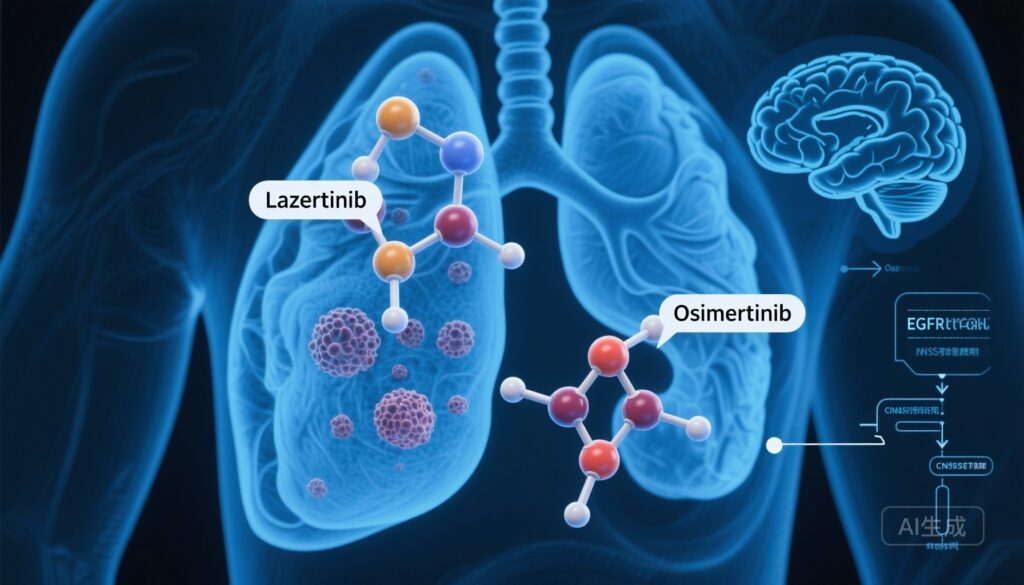Highlight
– In the MARIPOSA exploratory, double-blind comparison, lazertinib monotherapy produced median progression-free survival (PFS) of 18.5 months versus 16.6 months for osimertinib (HR 0.98; p = 0.86), indicating comparable efficacy.
– Objective response rates (ORR) and median duration of response (DoR) were similar between arms (ORR 83% vs 85%; DoR 16.6 vs 16.8 months).
– At interim analysis, median overall survival (OS) was not reached in either arm (HR 1.00). Safety profiles were broadly comparable; lazertinib had lower rates of QT interval prolongation than osimertinib.
Background
Activating mutations in the epidermal growth factor receptor (EGFR) gene (most commonly exon 19 deletions and exon 21 L858R) drive a substantial subset of non–small-cell lung cancers (NSCLC), particularly among never-smokers and individuals of East Asian ancestry. EGFR tyrosine kinase inhibitors (TKIs) are the standard first-line therapy for patients with sensitizing EGFR mutations. Third‑generation EGFR TKIs were developed to potently inhibit both sensitizing and resistance-associated (T790M) EGFR mutations while sparing wild-type EGFR to reduce skin and gastrointestinal toxicities and to improve central nervous system (CNS) activity.
Osimertinib established a new standard of care in the first-line setting after the phase 3 FLAURA trial demonstrated superior PFS and a favorable CNS activity profile versus first‑generation TKIs (gefitinib or erlotinib) (Soria et al., NEJM 2018). Lazertinib is a brain-penetrant, third‑generation EGFR TKI selected for combination strategies because of its preclinical activity and reportedly lower wild-type EGFR–related adverse effects. The phase 3 MARIPOSA study randomized patients to amivantamab+lazertinib, osimertinib, or lazertinib monotherapy to understand the relative contribution of combination components and to include a head-to-head comparison between two third-generation EGFR TKIs.
Study design
MARIPOSA is a randomized, double-blind, phase 3 trial enrolling treatment‑naive participants with advanced EGFR-mutant NSCLC. A total of 1,074 participants were randomized in a 2:2:1 ratio to amivantamab plus lazertinib (n = 429), osimertinib monotherapy (n = 429), or lazertinib monotherapy (n = 216). The exploratory analysis reported here focuses on the head‑to‑head, double‑blind comparison between lazertinib monotherapy and osimertinib monotherapy.
Key endpoints included progression-free survival (PFS), objective response rate (ORR), duration of response (DoR), overall survival (OS; interim), and safety. Predefined subgroup analyses (for example, by common EGFR mutation subtype, baseline CNS metastases) were prespecified to assess consistency of effect across clinically relevant strata. Median follow-up at the time of the analysis was 22.0 months.
Key findings
Primary efficacy outcomes
At median follow-up of 22.0 months, the median PFS was 18.5 months for lazertinib versus 16.6 months for osimertinib (hazard ratio [HR] = 0.98; 95% confidence interval [CI]: 0.79–1.22; p = 0.86). The HR close to 1 and a non‑significant p value indicate no evidence of a difference in PFS between the two third‑generation TKIs in this exploratory comparison.
Response rates and durability
Among participants with measurable disease at baseline, ORR was 83% with lazertinib and 85% with osimertinib. Median DoR among confirmed responders was 16.6 months for lazertinib and 16.8 months for osimertinib. These near-identical response metrics underscore comparable antitumor activity in the measurable-disease subset.
Overall survival
At the time of the preplanned interim OS analysis, median OS was not reached in either arm; HR for OS was 1.00 (95% CI: 0.73–1.38), indicating no difference between arms in the available follow-up. Longer follow-up will be necessary to exclude small differences in OS and to capture subsequent-line therapies’ impact.
Subgroup analyses
PFS results were reported as comparable between arms across predefined subgroups, including common EGFR mutation subtypes (exon 19 deletion and L858R) and presence or absence of baseline CNS metastases. Although the exploratory nature of these subgroup analyses limits formal statistical inference, consistency across clinically important strata supports the overall conclusion of similar efficacy.
Safety
Adverse events for both agents were mostly grade 1–2 and consistent with expected on-target EGFR inhibition (e.g., dermatitis acneiform, diarrhea). Notably, lazertinib was associated with lower rates of QT interval prolongation compared with osimertinib in this analysis. Cardiac adverse events—QT prolongation and, less commonly, decreases in left ventricular ejection fraction—have been reported with osimertinib and are included in product labeling; the reduced frequency of QT prolongation with lazertinib may factor into individual patient treatment choice for patients at higher baseline cardiac risk.
Interpretation and clinical implications
This is the first randomized, double‑blind comparison between two third‑generation EGFR TKIs in previously untreated EGFR‑mutant advanced NSCLC. The overall message is that lazertinib monotherapy achieved efficacy outcomes that are comparable to osimertinib for PFS, ORR, DoR, and interim OS, with a broadly similar safety profile and fewer QT prolongation events.
For clinicians, these data suggest that lazertinib may be an alternative to osimertinib as first-line EGFR-targeted therapy, pending regulatory status, availability, and longer-term outcomes. The choice between third‑generation TKIs may be informed by individual comorbidities (for example, baseline cardiac disease), drug access, and evolving data on resistance patterns and sequencing.
Expert commentary and limitations
Strengths of this analysis include randomization, double-blind design, and substantial sample size for an exploratory monotherapy comparison embedded in a larger phase 3 program. The similar efficacy across major subgroups, including patients with CNS involvement, is reassuring given the clinical importance of intracranial disease control in EGFR‑mutant NSCLC.
Key limitations to bear in mind: the comparison is exploratory because the MARIPOSA study was powered primarily to test the superiority of amivantamab+lazertinib versus osimertinib for PFS. As a result, the monotherapy comparison may not have been powered to detect small differences between lazertinib and osimertinib. The follow-up reported here (median 22.0 months) is meaningful but still interim for OS. Finally, generalizability to diverse global populations will depend on enrollment demographics and subsequent-line therapy patterns; cross-trial comparisons with FLAURA should be undertaken cautiously because of differing trial designs and control arms.
Mechanistically, both agents are third-generation, covalent EGFR inhibitors with CNS penetration; minor differences in pharmacokinetics, off‑target profiles, and binding properties may explain observed tolerability differences (e.g., QT signals). Future translational data from MARIPOSA and other studies may shed light on differential resistance pathways emerging after first‑line exposure to each agent.
Practical considerations for practice and research
– Patient selection: Pending local regulatory approvals and formulary inclusion, lazertinib may be considered where available as an alternative first-line serviceable EGFR TKI, particularly in patients with higher baseline QT risk.
– Monitoring: Baseline and periodic ECG monitoring remains prudent with EGFR TKIs that carry QT liability; cardiac function monitoring should be individualized.
– Sequencing and resistance: Prospective biomarker studies and post-progression sequencing data are needed to determine optimal sequencing strategies and to identify whether resistance mechanisms differ meaningfully between agents.
– Future research: Longer-term OS data, head-to-head powered comparisons, and mechanistic translational analyses will clarify whether subtle differences translate into clinically meaningful outcomes for subpopulations.
Conclusion
In this randomized, double‑blind exploratory analysis of MARIPOSA, lazertinib monotherapy demonstrated comparable efficacy and overall safety to osimertinib as first-line treatment for advanced EGFR‑mutant NSCLC, including among prespecified subgroups. The finding of fewer QT prolongation events with lazertinib may be relevant for patients at elevated cardiac risk. These results support consideration of lazertinib as an alternative third‑generation EGFR TKI, while longer follow-up and further translational and comparative data are awaited to guide definitive positioning in treatment algorithms.
Funding and clinicaltrials.gov
Funding and trial support are reported in the primary publication: Lee SH et al., Lazertinib Versus Osimertinib in Previously Untreated EGFR‑Mutant Advanced NSCLC: A Randomized, Double‑Blind, Exploratory Analysis From MARIPOSA (J Thorac Oncol. 2025). For detailed funding statements and trial registration identifiers, please refer to the primary manuscript.
References
1. Lee SH, Lu S, Hayashi H, et al. Lazertinib Versus Osimertinib in Previously Untreated EGFR‑Mutant Advanced NSCLC: A Randomized, Double‑Blind, Exploratory Analysis From MARIPOSA. J Thorac Oncol. 2025 Nov;20(11):1655-1668. doi:10.1016/j.jtho.2025.06.030.
2. Soria J‑C, Ohe Y, Vansteenkiste J, et al. Osimertinib in Untreated EGFR‑Mutated Advanced Non–Small‑Cell Lung Cancer. N Engl J Med. 2018;378(2):113–125. doi:10.1056/NEJMoa1713137.
3. Tagrisso (osimertinib) Prescribing Information. AstraZeneca/US FDA. (Refer to the most recent label for safety information including QT interval prolongation and cardiomyopathy warnings.)
4. NCCN Clinical Practice Guidelines in Oncology: Non–Small Cell Lung Cancer. National Comprehensive Cancer Network. (Consult current NCCN guidance for details on molecular testing and first-line management of EGFR-mutant NSCLC.)



